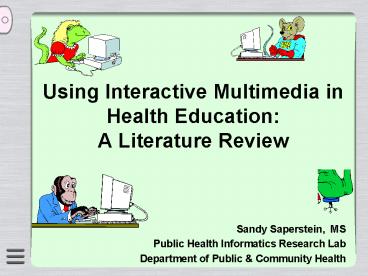Using Interactive Multimedia in Health Education: A Literature Review - PowerPoint PPT Presentation
1 / 17
Title:
Using Interactive Multimedia in Health Education: A Literature Review
Description:
To affect health attitudes or behaviors ... 16 total articles. 13 from Medline search 3 additional articles. Published between 1997 2003 ... Nutrition. Findings ... – PowerPoint PPT presentation
Number of Views:213
Avg rating:3.0/5.0
Title: Using Interactive Multimedia in Health Education: A Literature Review
1
Using Interactive Multimedia in Health Education
A Literature Review
- Sandy Saperstein, MS
- Public Health Informatics Research Lab
- Department of Public Community Health
2
Acknowledgements
- Dr. Nancy Atkinson
- Dr. Bob Gold
- Department of Public and Community Health Faculty
3
Research Questions
- How are behavior change theories being used to
guide the development of interactive multimedia
in health education? - What instructional methods have been used in
interactive multimedia in health education and
what is their effectiveness?
4
Method Literature Review
- Search Strategy Medline
- Dates 1966 - March 2003
- Keywords
- Interactive Multimedia - 291 abstracts
- Interactive Multimedia Health Education - 49
abstracts - 26 abstracts selected for review
5
Inclusion Criteria
- Multimedia Intervention
- For general population or sub-population
- To affect health attitudes or behaviors
- Includes theoretical framework or instructional
design discussion - English language
6
Exclusion Criteria
- Intervention designed solely to
- increase knowledge
- aid in patient/physician decision-making
- to educate healthcare providers
7
Data Extraction
- 16 total articles
- 13 from Medline search 3 additional articles
- Published between 1997 2003
- Study types
- 2 Randomized clinical trials
- 10 Pre-experimental designs
- 4 Descriptive articles
- Ages targeted
- Children 33
- Adolescent 27
- Adult 40
8
Health Education Areas
9
Findings
- 4 critical planning elements for computer-based
instructional design(Hardin Reis, 1997) - Audience
- Objectives
- Methods
- Evaluation
10
1. Audience
- Literature review formative research
- 73 reported doing focus groups
- Role of theory
11
2. Objectives
- What will the user specifically achieve by using
your program? - Clear, specific objectives drive the next phases
of development
12
Health Behavior Theories
13
3. Methods
- Commonly used methods
- tutorials
- hypermedia
- drill and practice
- problem-solving
- games
- simulations
Body Fun, 1994
14
Methods to Influence Self-Efficacy
- Simulations
- Video clips
- Supportive corrective feedback
- Coach
Body Fun Prototypes, 2003
15
4. Evaluation
- Increases in self-efficacy
- Eating low-fat foods, handling conflict, sexual
decision-making, preventing HIV, refusing
marijuana - Behavior changes
- Increased fruit vegetable consumption, setting
and achieving nutrition goals, intention to
perform HIV prevention behaviors, intention to
refuse marijuana - No change in skin CA prevention behaviors, ER
visits for asthma patients.
16
Limitations
- Preliminary report
- Additional search terms computer-assisted
instruction - Additional databases
- Additional theory
- Biased search
17
Future Directions
Better use of computer capacity?
Which methods are more effective? Why do they
work?
O
Application of other health behavior theories?































